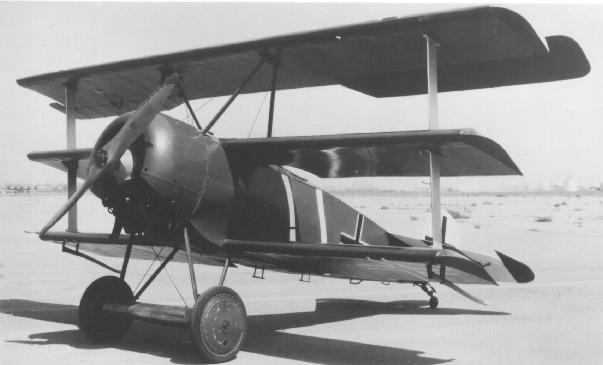The Gnome was one of several rotary engines popular on fighter planes during World War I. In this type of engine, the crankshaft is mounted on the airplane, while the crankcase and cylinders rotate with the propeller.
http://members.lycos.co.uk/gary1024/gnome.gif
The Gnome was unique in that the intake valves were located within the pistons. Otherwise, this engine used the familiar Otto four stroke cycle. At any given point, each of the cylinders is in a different phase of the cycle. In the following discussion, follow the master cylinder with the green connecting rod.
During this portion of the stroke, a vacuum forms in the cylinder, forcing the intake valve open and drawing the fuel-air mixture in from the crankcase.
http://members.lycos.co.uk/gary1024/Gnome_intake.gif
The mixture is compressed during this phase. The spark plug fires toward the end of the compression stroke, slightly before top dead center.
http://members.lycos.co.uk/gary1024/Gnome_compression.gif
The power stroke happens here. Note that the exhaust valve opens early -- well before bottom dead center.
http://members.lycos.co.uk/gary1024/Gnome_power.gif
This engine has a fairly long exhaust stroke. In order to improve power or efficiency, engine valve timing often varies from what one might expect.
http://members.lycos.co.uk/gary1024/Gnome_exhaust.gif
When I first learned how these engines worked, I thought the only person crazier than the engine designer was the one who paid money for it. At first glance it seems ridiculously backwards.
Nonetheless, a number of engines were designed this way, including the Gnome, Gnome Monosoupape, LeRhone, Clerget, and Bentley to name a few. It turns out there were some good reasons for the configuration:
Balance. Note that the crankcase and cylinders revolve in one circle, while the pistons revolve in another, offset circle. Relative to the engine mounting point, there are no reciprocating parts. This means there's no need for a heavy counterbalance.
Air Cooling. Keeping an engine cool was an ongoing challenge for early engine designers. Many resorted to heavy water cooling systems. Air cooling was quite adequate on rotary engines, since the cylinders are always in motion.
No flywheel. The crankcase and cylinders provided more than adequate momentum to smooth out the power pulses, eliminating the need for a heavy flywheel.
All these factors gave rotary engines the best power-to-weight ratio of any configuration at the time, making them ideal for use in fighter planes. Of course, there were disadvantages as well:
Gyroscopic effect. A heavy spinning object resists efforts to disturb its orientation (A toy gyroscope demonstrates the effect nicely). This made the aircraft difficult to maneuver.
Total Loss Oil system. Centrifugal force throws lubricating oil out after its first trip through the engine. It was usually castor oil that could be readily combined with the fuel. (The romantic-looking scarf the pilot wore was actually a towel used to wipe the slimy stuff off his goggles!)
The aircraft's range was thus limited by the amount of oil it could carry as well as fuel. Most conventional engines continuously re-circulate a relatively small supply of oil.
http://members.lycos.co.uk/gary1024/gnome.gif
The Gnome was unique in that the intake valves were located within the pistons. Otherwise, this engine used the familiar Otto four stroke cycle. At any given point, each of the cylinders is in a different phase of the cycle. In the following discussion, follow the master cylinder with the green connecting rod.
During this portion of the stroke, a vacuum forms in the cylinder, forcing the intake valve open and drawing the fuel-air mixture in from the crankcase.
http://members.lycos.co.uk/gary1024/Gnome_intake.gif
The mixture is compressed during this phase. The spark plug fires toward the end of the compression stroke, slightly before top dead center.
http://members.lycos.co.uk/gary1024/Gnome_compression.gif
The power stroke happens here. Note that the exhaust valve opens early -- well before bottom dead center.
http://members.lycos.co.uk/gary1024/Gnome_power.gif
This engine has a fairly long exhaust stroke. In order to improve power or efficiency, engine valve timing often varies from what one might expect.
http://members.lycos.co.uk/gary1024/Gnome_exhaust.gif
When I first learned how these engines worked, I thought the only person crazier than the engine designer was the one who paid money for it. At first glance it seems ridiculously backwards.
Nonetheless, a number of engines were designed this way, including the Gnome, Gnome Monosoupape, LeRhone, Clerget, and Bentley to name a few. It turns out there were some good reasons for the configuration:
Balance. Note that the crankcase and cylinders revolve in one circle, while the pistons revolve in another, offset circle. Relative to the engine mounting point, there are no reciprocating parts. This means there's no need for a heavy counterbalance.
Air Cooling. Keeping an engine cool was an ongoing challenge for early engine designers. Many resorted to heavy water cooling systems. Air cooling was quite adequate on rotary engines, since the cylinders are always in motion.
No flywheel. The crankcase and cylinders provided more than adequate momentum to smooth out the power pulses, eliminating the need for a heavy flywheel.
All these factors gave rotary engines the best power-to-weight ratio of any configuration at the time, making them ideal for use in fighter planes. Of course, there were disadvantages as well:
Gyroscopic effect. A heavy spinning object resists efforts to disturb its orientation (A toy gyroscope demonstrates the effect nicely). This made the aircraft difficult to maneuver.
Total Loss Oil system. Centrifugal force throws lubricating oil out after its first trip through the engine. It was usually castor oil that could be readily combined with the fuel. (The romantic-looking scarf the pilot wore was actually a towel used to wipe the slimy stuff off his goggles!)
The aircraft's range was thus limited by the amount of oil it could carry as well as fuel. Most conventional engines continuously re-circulate a relatively small supply of oil.

